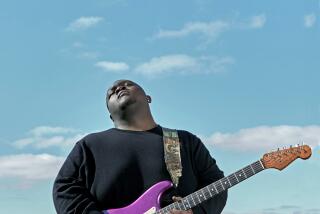Touching the Heart and Mind
- Share via
Jazz pianists have, in effect, the melodic, rhythmic and harmonic potential of an orchestra at their fingertips. So it’s not surprising that most (with some obvious exceptions) are generally content as leaders to work in basic trio and quartet formats.
But not Kenny Barron, a firm believer in musical eclecticism--an eclecticism clearly present in this superb new recording.
Widespread recognition has come slowly for the 54-year-old Barron, who, in the last few years, has finally come to be acknowledged (with first-place wins in both the Down Beat and Jazz Times Polls) as one of the finest pianists in jazz. A professor in Rutgers University jazz studies program for the last 25 years, he has performed with virtually everyone in jazz, from work as a sideman with Dizzy Gillespie, Freddie Hubbard, Milt Jackson and dozens of others to his brilliant series of recordings with Stan Getz.
For his own outings as a leader, however, Barron has almost always chosen to open up the floodgates of musical imagination. He has worked in numerous trio settings, always with dynamic such associates as bassists Dave Holland, Ron Carter and Ray Drummond, and drummers Victor Lewis and Ben Riley.
He also has recorded such albums as the Brazilian-tinged “Sambao” and the brilliantly creative interaction with percussionist Mino Cinelu in last year’s “Swamp Sally” (both albums were nominated for Grammys).
With “Things Unseen,” Barron is in familiar company, with Lewis and Cinelu present, as well as two other frequent associates, saxophonist John Stubblefield and trumpeter Eddie Henderson. Guitarist John Scofield, violinist Naoko Terai and bassist David Williams make up the balance of the group.
Although the compositions are all original, they are crafted with the kind of melodic flow that makes them instantly memorable, from the dark, flowing rhythms of the opening “Marie Laveau” to the quick time articulation of “The Sequel,” the soul funk of “Christopher’s Dance,” the cosmopolitan elegance of “Joy Island” and the lovely, impressionistic violin and piano duet on “Rose Noire.”
The playing is universally well done, with Henderson’s Miles Davis-tinged muted trumpet and Stubblefield’s sturdy tenor saxophone especially impressive.
But the star of the proceedings is Barron, whose piano lines bristle with discovery and surprise. The combination of his playing and his consistently fascinating compositions makes for a model of how to produce a contemporary jazz recording that touches both the heart and the mind.
King’s album has strong procedural similarities to Barron’s CD. His ensemble includes three horns (alto saxophonist Steve Wilson, trombonist Steve Davis and tenor saxophonist David Sanchez), and eight of the 10 tunes were composed by the pianist.
Although King, who also is an attorney and an author, has not yet reached Barron’s level of creative maturity, he is rising quickly. A fast, articulate player whose roots trace to both Bud Powell and McCoy Tyner, he invests every track with a solid piano-based rhythmic drive and harmonic foundation.
The tunes are consistently provocative: bop-like and edgy on “The Third Rail” and “Lady Macbeth,” brightly tropical on “Cocabamba,” disjunct and angular on “Blues for Andrew Hill” and filled with startling twists and turns in virtually every piece (including King’s settings of Powell’s “So Sorry Please” and Tyner’s “For Tomorrow”). The horn players--especially Wilson and Sanchez--make substantial improvisational contributions, and the album is performed with an attractive, innate feeling of musical enthusiasm.
In King’s new book, “What Jazz Is” (Walker and Co., $12.95), he notes that “Jazz is a language through which musicians communicate ideas, emotions and images to each other and to listeners.” And, in this attractive collection, he is consistently true to his own insightful definition. Albums are rated on a scale of one star (poor) to four stars (excellent).
More to Read
The biggest entertainment stories
Get our big stories about Hollywood, film, television, music, arts, culture and more right in your inbox as soon as they publish.
You may occasionally receive promotional content from the Los Angeles Times.










